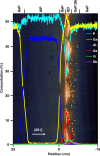Structural and compositional analysis of (InGa)(AsSb)/GaAs/GaP Stranski-Krastanov quantum dots
- PMID: 34127643
- PMCID: PMC8203795
- DOI: 10.1038/s41377-021-00564-z
Structural and compositional analysis of (InGa)(AsSb)/GaAs/GaP Stranski-Krastanov quantum dots
Abstract
We investigated metal-organic vapor phase epitaxy grown (InGa)(AsSb)/GaAs/GaP Stranski-Krastanov quantum dots (QDs) with potential applications in QD-Flash memories by cross-sectional scanning tunneling microscopy (X-STM) and atom probe tomography (APT). The combination of X-STM and APT is a very powerful approach to study semiconductor heterostructures with atomic resolution, which provides detailed structural and compositional information on the system. The rather small QDs are found to be of truncated pyramid shape with a very small top facet and occur in our sample with a very high density of ∼4 × 1011 cm-2. APT experiments revealed that the QDs are GaAs rich with smaller amounts of In and Sb. Finite element (FE) simulations are performed using structural data from X-STM to calculate the lattice constant and the outward relaxation of the cleaved surface. The composition of the QDs is estimated by combining the results from X-STM and the FE simulations, yielding ∼InxGa1 - xAs1 - ySby, where x = 0.25-0.30 and y = 0.10-0.15. Noticeably, the reported composition is in good agreement with the experimental results obtained by APT, previous optical, electrical, and theoretical analysis carried out on this material system. This confirms that the InGaSb and GaAs layers involved in the QD formation have strongly intermixed. A detailed analysis of the QD capping layer shows the segregation of Sb and In from the QD layer, where both APT and X-STM show that the Sb mainly resides outside the QDs proving that Sb has mainly acted as a surfactant during the dot formation. Our structural and compositional analysis provides a valuable insight into this novel QD system and a path for further growth optimization to improve the storage time of the QD-Flash memory devices.
Conflict of interest statement
The authors declare no competing interests.
Figures










References
LinkOut - more resources
Full Text Sources
Research Materials
Miscellaneous

